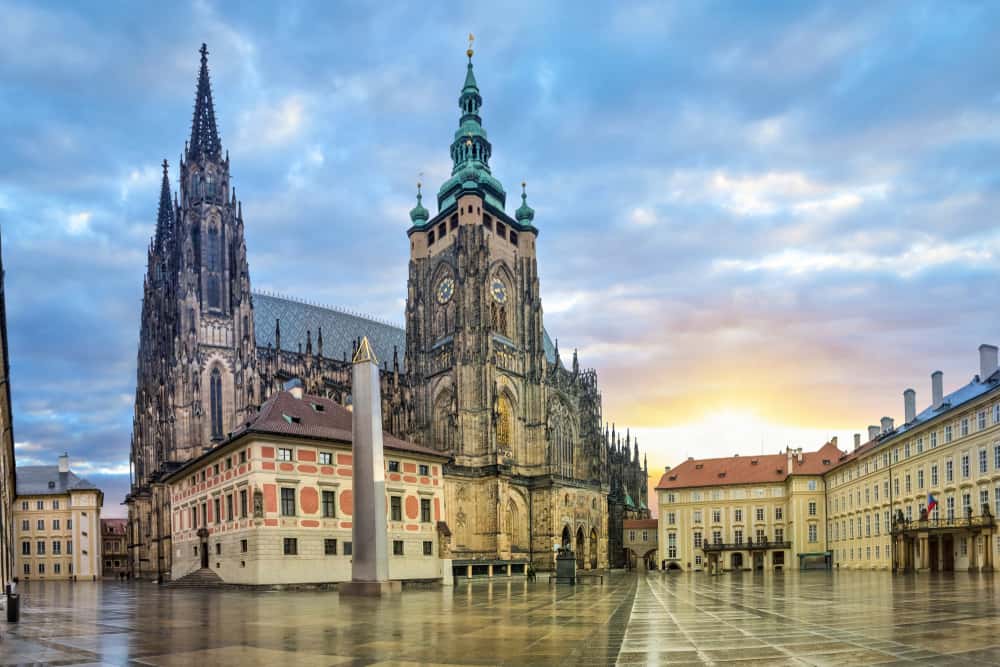November 13, 2023
St Vitus Cathedral: Prague’s Iconic Gothic Masterpiece

As you approach Prague Castle, you cannot miss the stunning St. Vitus Cathedral towering over the city. This magnificent cathedral is Prague’s largest and most important temple and a must-visit destination for anyone interested in history, architecture, or religion.
St. Vitus Cathedral has a rich history dating back to the 10th century and has undergone numerous renovations and additions over the centuries.
It is the final resting place of several patron saints, sovereigns, noblemen, and archbishops and has been the site of many important events, including coronations of Czech kings and queens.
The cathedral is a shining example of Gothic architecture, with its intricate details, soaring arches, and stunning stained glass windows.
Whether you are a local or a tourist, St. Vitus Cathedral is a must-see attraction in Prague. From its rich history to its stunning architecture, there is something for everyone to appreciate and admire.
So, grab your camera and prepare to be awed by the beauty and grandeur of this magnificent cathedral!
A Historical Overview of St. Vitus Cathedral

Interior of St. Vitus Cathedral in Prague, ©Dziewul / Shutterstock
St. Vitus Cathedral is a Gothic masterpiece located in Prague, Czech Republic. Its construction began in 1344 under the patronage of Charles IV, the Holy Roman Emperor and King of Bohemia.
Matthias of Arras designed it, and later by Peter Parler, who also designed the Charles Bridge and other notable buildings in Prague.
The cathedral is named after Saint Vitus, a Christian martyr from the 4th century. During the Hussite Wars in the 15th century, the cathedral was damaged and remained unfinished for centuries.
It was in the 19th century that the cathedral was finally completed. St. Vitus Cathedral symbolized Czech national pride and was the site of many important events in Czech history, including the coronations of Czech kings and queens.
The cathedral is the burial place of several patron saints and Czech kings, including Saint Wenceslaus, the Duke of Bohemia, and Charles IV.
Today, St. Vitus Cathedral remains a vital part of the religious and cultural life of the Czech state. Its architecture and rich history make it a popular tourist destination and an important symbol of Czech identity.
Intricate Sculptures and Breathtaking Design

Gothic architecture of St. Vitus Cathedral in Prague, ©Horvath / Shutterstock
St. Vitus Cathedral is a prime example of Gothic architecture characterized by its pointed arches, ribbed vaults, and flying buttresses.
The cathedral’s design nods to the Romanesque architecture of the Holy Roman Empire, particularly the abbey church in Hildesheim and the Speyer Cathedral.
Several architects have worked on the design of St. Vitus Cathedral over the centuries, including Matthias of Arras and Peter Parler in the 14th century and Josef Kranner, Josef Mocker, and Kamil Hilbert in the 19th century.
This is why the cathedral’s architecture is unique compared to other European cathedrals.
The Western facade of St. Vitus Cathedral is adorned with intricate sculptures and features a rose window that is 7 meters in diameter.
The Great South Tower, which stands 96.5 meters tall, offers a breathtaking view of Prague and is accessible to visitors who climb the 287 steps to the top.
The cathedral’s interior is equally impressive, with a nave that is 124 meters long and 33 meters wide. The transept, which is the area where the hub intersects with the choir, is adorned with beautiful stained glass windows.
The triforium, a narrow gallery that runs along the top of the nave arcade, is also worth seeing. The chancel, the area around the altar, is particularly ornate and features a stunning Gothic ribbed vault.
The dome above the chancel is also a masterpiece of Gothic architecture and is adorned with frescoes by Karel Škréta.
The construction work on St. Vitus Cathedral took several centuries to complete, which is why it showcases a diverse range of architectural styles, including Gothic, Renaissance, and Baroque.
Today, it is considered one of the icons of Prague and attracts over 2 million visitors each year.
Significant Sections to Explore

St. Vitus Cathedral and Habsburg Mausoleum, ©Grandi / Shutterstock
As you explore St. Vitus Cathedral, there are several important sections that you should take notice of. Here are some of the highlights:
South Tower
The South Tower of St. Vitus Cathedral is the tallest in the cathedral, reaching a height of 99 meters. You can climb to the top of the tower for stunning views of Prague and the surrounding area.
Golden Gate
The Golden Gate is the main entrance to St. Vitus Cathedral. It is adorned with beautiful sculptures and intricate details, and it is said that only the most important people were allowed to pass through it in the past.
Royal Mausoleum
The Royal Mausoleum is the final resting place of many members of the Czech royal family. The tombs are ornately decorated, and it is a peaceful and reflective space.
Royal Crypt
The Royal Crypt is located beneath the Royal Mausoleum and contains the remains of several Bohemian kings and queens. The space is dimly lit and has a somber atmosphere.
Crown Chamber
The Crown Chamber is where the Bohemian Crown Jewels are kept. The chamber is heavily guarded, and the jewels are only displayed on special occasions.
Crown Jewels Chamber
The Crown Jewels Chamber is where the Bohemian Crown Jewels were kept before they were moved to the Crown Chamber. The chamber is now used to display other treasures of the cathedral.
St. Wenceslas Chapel
The St. Wenceslas Chapel is the most ornate and decorated part of St. Vitus Cathedral. It is dedicated to the patron saint of the Czech Republic, and it contains his relics.
Shrine
The Shrine is a small chapel located near the St. Wenceslas Chapel. It contains the remains of St. John Nepomuk, a Czech martyr who was killed for refusing to divulge the queen’s confession.
Crossing
The Crossing is the central space of the cathedral where the main altar is located. Four massive pillars surround it, and the ceiling is adorned with beautiful Gothic rib vaults.
Sacristy
The Sacristy is where the priests prepare for mass. It contains ornate vestments and other religious artifacts.
Radiating Chapels
The Radiating Chapels are a series of small chapels located around the perimeter of the cathedral. They contain beautiful stained glass windows and other religious artwork.
Ambulatory
The Ambulatory is a circular walkway that surrounds the apse of the cathedral. It is lined with beautiful Gothic columns and contains several small chapels. As you can see, many significant sections of St. Vitus Cathedral exist to explore.
Each one has its unique history and beauty, and together, they make up one of the most impressive cathedrals in the world.
Medieval Craftsmanship and Creativity

The exterior design of St. Vitus Cathedral in Prague, ©Gurney / Shutterstock
St. Vitus Cathedral is not only known for its impressive Gothic architecture but also for its artistic features. The cathedral boasts a collection of stunning art pieces that add to its beauty and grandeur.
Here are some of the artistic highlights of St. Vitus Cathedral:
Reliefs
The cathedral’s exterior is adorned with intricate reliefs, which depict scenes from the Bible and the lives of saints. The reserves were created by some of the most skilled artists of the time and are a testament to the craftsmanship of the medieval period.
Stained Glass Windows
The stained glass windows of St. Vitus Cathedral are some of the most beautiful in the world. The windows are imposing when the sunlight shines through them, casting colorful patterns on the cathedral’s interior.
Art Nouveau
The cathedral also features Art Nouveau elements, added during a renovation in the early 20th century. The most notable Art Nouveau feature is the stained glass window designed by the famous Czech artist Alfons Mucha.
The window depicts the patron saints of the Czech lands and is a stunning example of Mucha’s artistry.
Last Judgement
One of the most impressive artistic features of St. Vitus Cathedral is the Last Judgement mosaic located on the cathedral’s ceiling.
The mosaic, created by the Czech artist Max Švabinský, depicts the final judgment of all humanity. The mosaic’s intricate details and vivid colors make it a true masterpiece.
Rose Window
The cathedral’s rose window is another stunning example of the cathedral’s artistic features. The cathedral’s west facade window features intricate tracery and stained glass.
The window was created in the 14th century and is one of Europe’s oldest and most beautiful rose windows. Overall, St. Vitus Cathedral’s artistic features are a testament to the skill and creativity of the artists who designed and created them.
Religious Site and Symbol of Catholic Faith

Catholic site and symbolism in St. Vitus Cathedral, ©Markovskiy / Shutterstock
St. Vitus Cathedral is a significant religious site and a symbol of the Catholic faith in the Czech Republic. The cathedral is dedicated to St. Vitus, a Christian martyr believed to have been killed for his faith in the early fourth century.
As a patron saint, St. Vitus is venerated by Catholics all over the world. The cathedral is also home to the remains of several other patron saints, including St. Wenceslaus, the patron saint of the Czech Republic.
St. Wenceslaus was a martyr killed by his brother in the year 935. His remains are kept in the cathedral’s Treasury, a popular Catholic pilgrimage site.
St. Vitus Cathedral is a basilica, a church the Pope designates with special religious significance. The cathedral is the seat of the Archbishop of Prague, often referred to as the Metropolitan Cathedral of Saints Vitus, Wenceslaus, and Adalbert.
The cathedral is a popular location for Mass and other religious ceremonies. The cathedral’s architecture and artwork are also significant to the Catholic faith.
The cathedral’s stained glass windows depict scenes from the lives of Christ and the saints, and the cathedral’s sculptures and carvings are also religious.
St. Vitus Cathedral is an essential site for Catholics in the Czech Republic and worldwide. Its history, architecture, and religious significance make it a must-see destination for anyone interested in the Catholic faith and its history.
Legends and Stories

The stained glass window in St. Vitus Cathedral, ©jorisvo / Shutterstock
St. Vitus Cathedral has been the center of many legends and stories. One of the most famous legends is about the cathedral’s namesake, Saint Vitus.
According to the legend, Vitus was a Christian martyr from Sicily who was thrown into a boiling pot of oil by the Roman Emperor Diocletian but emerged unscathed.
He was later thrown into a lion’s den but protected by an angel. This legend made Vitus a famous saint, and the cathedral was dedicated to his life and works.
Another legend involves the cathedral’s other patron saints, Wenceslaus and Adalbert. Wenceslaus, the Duke of Bohemia, was assassinated by his brother in 935 AD.
Adalbert, a bishop, was killed by pagan Prussians in 997 AD. Both saints were buried at the cathedral, and their tombs became pilgrimage sites.
There is also a legend about oversleeping. According to the legend, the cathedral’s architect overslept on the day of the cathedral’s consecration and missed the ceremony.
He jumped from the cathedral’s roof as punishment, but an angel caught him and saved his life. The architect then carved a statue of the angel and placed it on the cathedral’s facade.
One more legend involves a dog bite. It is said that during the cathedral’s construction, a worker’s dog was bitten by a poisonous snake.
The worker ran to the cathedral and prayed to Saint Vitus for help. The dog was miraculously healed, and the worker carved a statue of the dog and placed it on the cathedral’s facade as a tribute.
These legends and stories add to the mystique and charm of St. Vitus Cathedral, making it a religious site and a cultural and historical landmark.
A Symbol of Czech Gothic Architecture

St. Vitus Cathedral in Prague, ©Garmyder / Shutterstock
St. Vitus Cathedral is not only an architectural masterpiece, but it also holds great cultural significance for the Czech people. As Czechia’s largest and most important church, it has played a significant role in the country’s history and culture.
The cathedral is located within Prague Castle, symbolizing Czech national identity and a popular tourist destination.
The castle has been the seat of power for Czech rulers and presidents for over a thousand years, and it is also home to the Bohemian Crown Jewels, which are kept in a hidden room inside the cathedral.
St. Vitus Cathedral is also closely linked to the Charles Bridge, one of the most iconic landmarks in Prague. The bridge connects the castle to the Old Town and has been an important trade route since the 14th century.
The cathedral’s towers can be seen from the bridge, and the view of the bridge from the cathedral is equally impressive. The cathedral symbolizes Czech Gothic architecture and was built over centuries by several architects.
Its construction began in 1344 under the patronage of Charles IV, the Holy Roman Emperor and King of Bohemia. It was finally completed in 1929, almost 600 years after its construction began.
Other important landmarks near the cathedral include the Powder Tower, one of the original gates to the Old Town.
Guidelines for Visitors

The crowd of tourists outside the St. Vitus Cathedral in Prague, ©Andy / Shutterstock
Here is some vital information if you plan to visit St. Vitus Cathedral:
Opening Hours
The cathedral is open every day of the week except for certain holidays. The opening hours vary depending on the season, so checking the official website before planning your visit is recommended. The latest possible entry to the cathedral is 20 minutes before closing.
Admission Fees
There are two options for visiting the cathedral – a free tour or a paid tour.
The free tour includes access to the nave and the crypt, while the paid time provides access to the entire cathedral, including the tower and the Golden Gate.
The admission fees vary depending on the type of tour you choose and your age. Children under the age of 6 can enter for free.
Dress Code
Visitors are required to dress modestly when entering the cathedral. Shorts, tank tops, and revealing clothing are not allowed. It is recommended to wear comfortable shoes as the cathedral has many stairs and uneven surfaces.
Photography
Photography is allowed inside the cathedral, but flash and tripods are prohibited. It is also essential to respect other visitors and not use photography equipment in a way that disrupts the experience of others.
Accessibility
The cathedral is accessible to visitors with disabilities. There is a wheelchair ramp at the entrance, and elevators are available to access the upper levels of the cathedral. Visitors with hearing impairments can also request a sign language interpreter for the tour.
Ready to experience Medieval Prague like never before? Purchase your ticket now and step into an augmented-reality adventure!
















